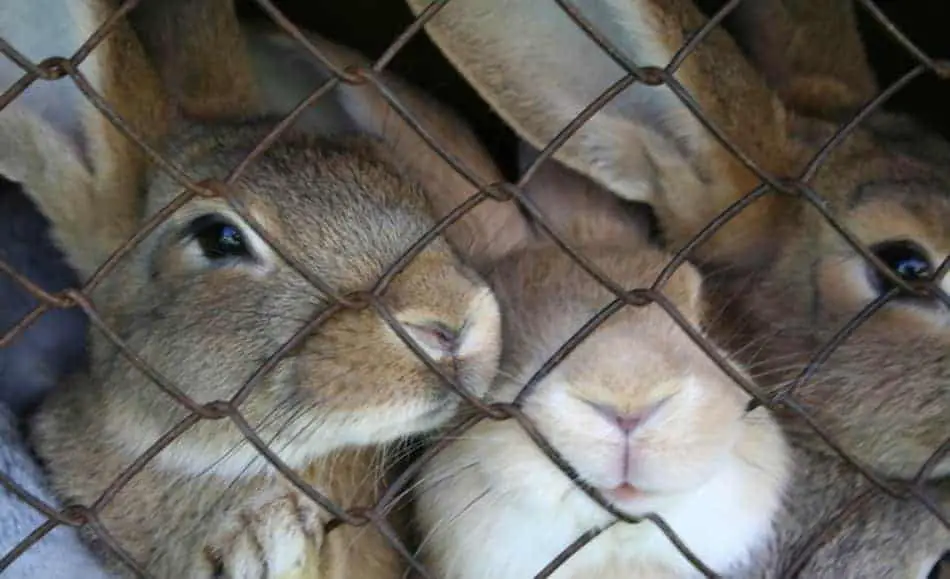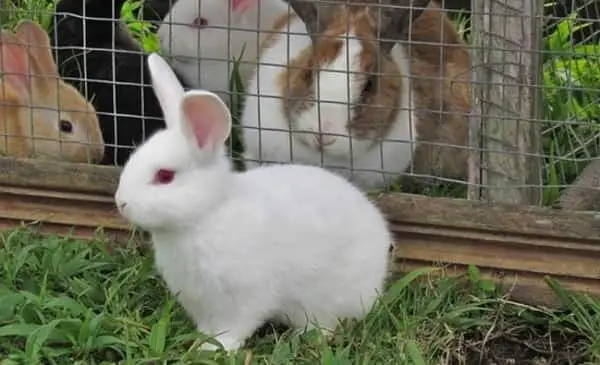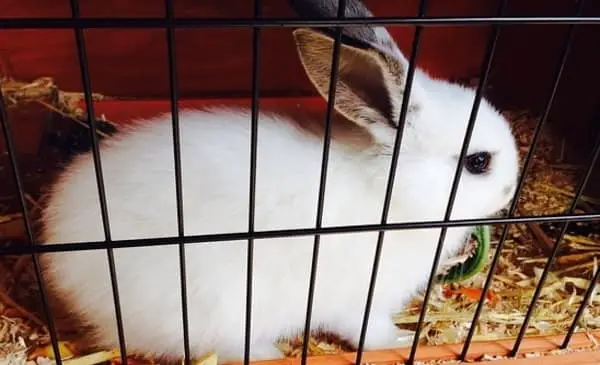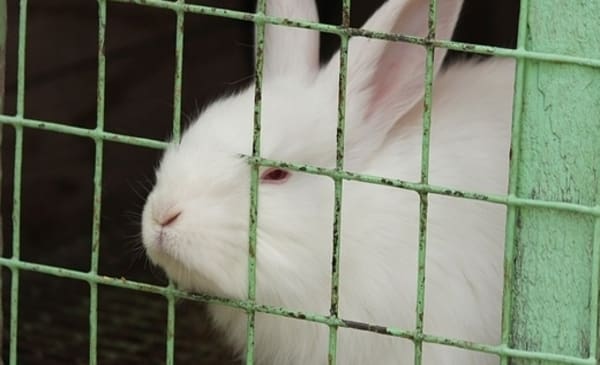Rabbits have extremely strong mating instincts. As animals near the bottom of the natural food chain, it’s an essential part of keeping their species alive. The desire to breed and propagate is one of the main things that drives what they do. In a pet situation, this can lead to complications, from behavioral issues to unplanned litters of baby bunnies.
So, can rabbits breed through a cage? Without going into the details of how exactly rabbits get it done, let’s just say it would be very difficult and is highly unlikely that a pair of rabbits will mate through a wire cage. However—it has happened on occasion.
This article will examine a few accounts of rabbits mating through cages and discuss what kind of cages or fences might allow it to occur. We’ll then take a look at a few other sneaky ways a rabbit may manage a “mystery” litter and discuss ways to be sure your bunnies do not breed without your consent.
How Do Rabbits Mate?
Rabbits mate through a process known as copulation, which involves specific behaviors and anatomical characteristics. When rabbits are ready to mate, the male, also known as a buck, will often exhibit increased territorial and courtship behaviors. This can include marking his territory with urine and attempting to mount the female, known as a doe.
Characteristics of rabbit mating behavior include the male chasing the female, nipping at her, and performing a “falling over” maneuver called a “binky” to attract her attention. The female may respond by becoming more receptive, lifting her tail, and eventually allowing the male to mount her.
During copulation, the male rabbit mounts the female from behind, and the entire process is typically brief but intense. It’s essential to note that female rabbits can be selective about their mates, and successful mating depends on the compatibility and willingness of both individuals.
In captivity, such as when rabbits are kept in cages, providing a suitable and spacious environment for mating is crucial to ensure the comfort and well-being of the rabbits during this natural reproductive behavior.
Observed Instances and Cage Specifics
Although it is a rare occurrence and difficult to imagine, experienced rabbit owners claim to have seen it happen on occasion—male and female rabbits in adjacent cages have managed to mate through the wire. Presumably, the rabbits were separated by only one layer of fencing with openings large enough for them to interact.
In other instances, rabbits kept completely separate to the owner’s knowledge were never seen to breed, yet somehow managed to produce a litter of kits. It is possible that in some of these cases, the rabbits managed to mate through the cage, although other explanations can be offered for most of them.
What Kind of Cage Can Rabbits Mate Through?
In order for rabbits to mate through a cage, there must be a certain amount of space between the bars. It could possibly happen if cages are adjacent and bars are two or more inches apart. It may also happen if you are keeping one rabbit in a cage with larger openings like a dog crate while the other is loose.
Rabbits have been observed to mate through a chain link fence or one with similar sized openings.
On the other hand, cages made of hardwire cloth or another fine mesh will be too tight for rabbits to get close enough to one another. Rabbits will also be unlikely to mate through a cage with a solid base that continues upward for several inches around the bottom.
Will a Wild Rabbit Mate With a Caged Domestic Rabbit?
It depends on where you live. Domestic rabbits were bred from European rabbits which are a completely different species than the cottontail rabbits and jackrabbits found in America. Although a domestic rabbit and a wild cottontail could conceivably try to mate if given the chance, it would not result in any offspring as their genetic makeup is too diverse.
You should still use caution if housing your rabbit outdoors as it could still attract the attention of native species, resulting in fights or the introduction of disease. A solid fence, raised hutch, or 1×1 hardware cloth is the best way to be sure a wild rabbit can’t get too close to your bunny when it is outdoors.
Other Explanations for Mystery Litters
The rabbit’s body is capable of some pretty astonishing reproductive feats. It was designed to keep the fragile species alive in the wild where a rabbit’s average lifespan is only one to two years. Rabbits can breed and become pregnant from the time they are just 12 weeks old, and unlike most animals, females do not have to come “in heat” to be fertile.
For them, mating triggers the release of eggs and thus pregnancy.
This quickness to mature and ease of conception can lead to unexpected pregnancies that seem almost impossible. Although mating through the cage has been known to occur, there are several other surprising ways rabbits may manage to mate unbeknownst to their owners.
The Rabbits Mated Before They Were Separated
If an unneutered male and female rabbit are together at any time after they are old enough to mate, there’s a very high chance that they will. So even though a rabbit may be considered a juvenile until it is six months old, it often becomes sexually mature before hitting that age.
Young rabbits are often transferred to their new home or a pet shop between eight to twelve weeks, but if they are not kept strictly separate from the opposite sex during that time, mating could occur, resulting in a pregnant rabbit that no one was expecting.
The Rabbits Bred Twice
A rabbit’s gestation period is 30 days, and they can breed again almost immediately after the kits are born—or in some cases, a few days before the kits are born.
Yes, you heard that right. If a female rabbit is in with a male right up until she’s pregnant, they may mate again up to four days before the first litter of kits is born and another litter will start forming in the rabbit’s oviduct. In this case the surprise second litter will be born about 25 days after the first.
The Buck Was Recently Neutered
A mature male rabbit does not immediately become sterile upon being neutered. Any sperm that has already been produced will remain viable for up to six weeks after the operation. If a doe is with the buck during this time, she still may become pregnant from him even though he’s neutered.
An Opening or Tunnel
Some rabbits can be quite the escape artists, and the desire to breed can be an intense motivator. Two rabbits separated by a cage or fence may still find a way to get together long enough to mate.
If they are on the ground, one could have dug a shallow tunnel to the other. They can also force their way through very small openings—any opening big enough for them to squeeze their heads through, they can squeeze their entire body through.
Other Theories
Rabbits breed and produce so easily, it’s not unusual for a rabbit owner to be completely mystified by a litter of kits when it seems impossible that their rabbits could have mated. A lot of speculation has been raised as to whether or not female rabbits can store sperm or even produce asexually.
There is no evidence that female rabbits can store sperm and become pregnant days after having been with a male. Although asexual reproduction—or parthenogenesis—does occur naturally in some animal species and has been induced in rabbits, it is much more likely that two rabbits simply figured out a way to steal a few seconds together, even through a wire cage.
How to Keep Your Rabbits From Mating
The only foolproof way to ensure that a male and female do not mate is to have one or both (preferably) neutered and keep them apart until the male is definitely sterile. Having your rabbits neutered is highly recommended for many reasons.
- It can reduce behavioral issues like territorial marking, mounting, and aggression.
- It reduces the risk of cancer and other diseases.
- Your rabbits will be more content.
- Your rabbits won’t injure themselves trying to get through fences to each other.
- You will not be adding to overpopulation of unwanted pets with an unplanned litter of kits.
Separate Cages
Unneutered male and female rabbits 12 weeks old or older should be kept in separate cages. If you are afraid mating through the cage may be possible, separate the cages by at least a few inches and don’t allow the rabbits out around each other or each other’s cages.
Penetration-Proof Cages
Rabbit cages and runs can be built to specifics that will ensure your rabbits cannot mate through the wire or escape into one another’s spaces. These specifics should include either a floor or partially buried fencing to keep the rabbits from digging under.
There should be no gaps between wires or corners. Some rabbit owners recommend wrapping the bottom 12 inches of a cage a fine wire mesh or chicken wire to ensure your rabbits will not be able to mate through it.
Separate Rooms
If your rabbits free range in your home, it’s best to keep unneutered males and females in completely separate areas of the house. Make sure all family members and housemates know they are to remain separate and keep at least one door closed between the two rooms. Many rabbits will climb or push over any kind of child gate or blockade.
Conclusion
Rabbits are notorious for their powerful instincts to reproduce, and if left to themselves, they will mate in any way possible. This can be an issue if the rabbits injure themselves trying to get to each other or if you are unprepared to deal with a litter of kits.
You can keep mating from happening by spaying and neutering your pets and keeping any intact rabbits as far from each other as possible.





